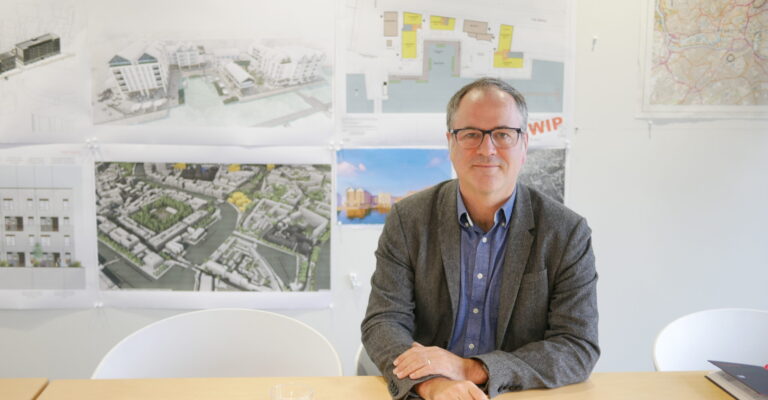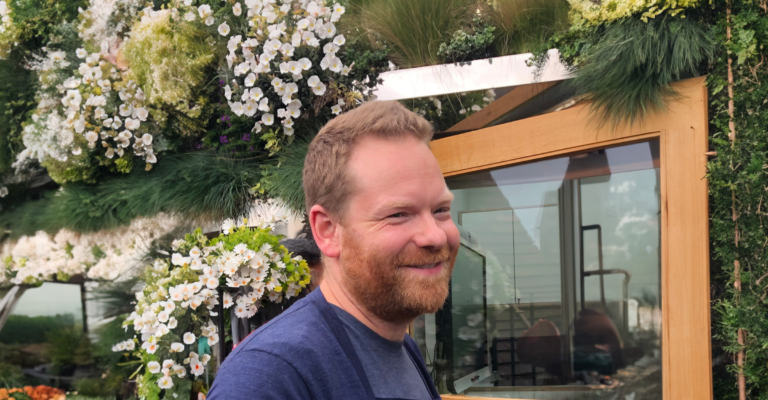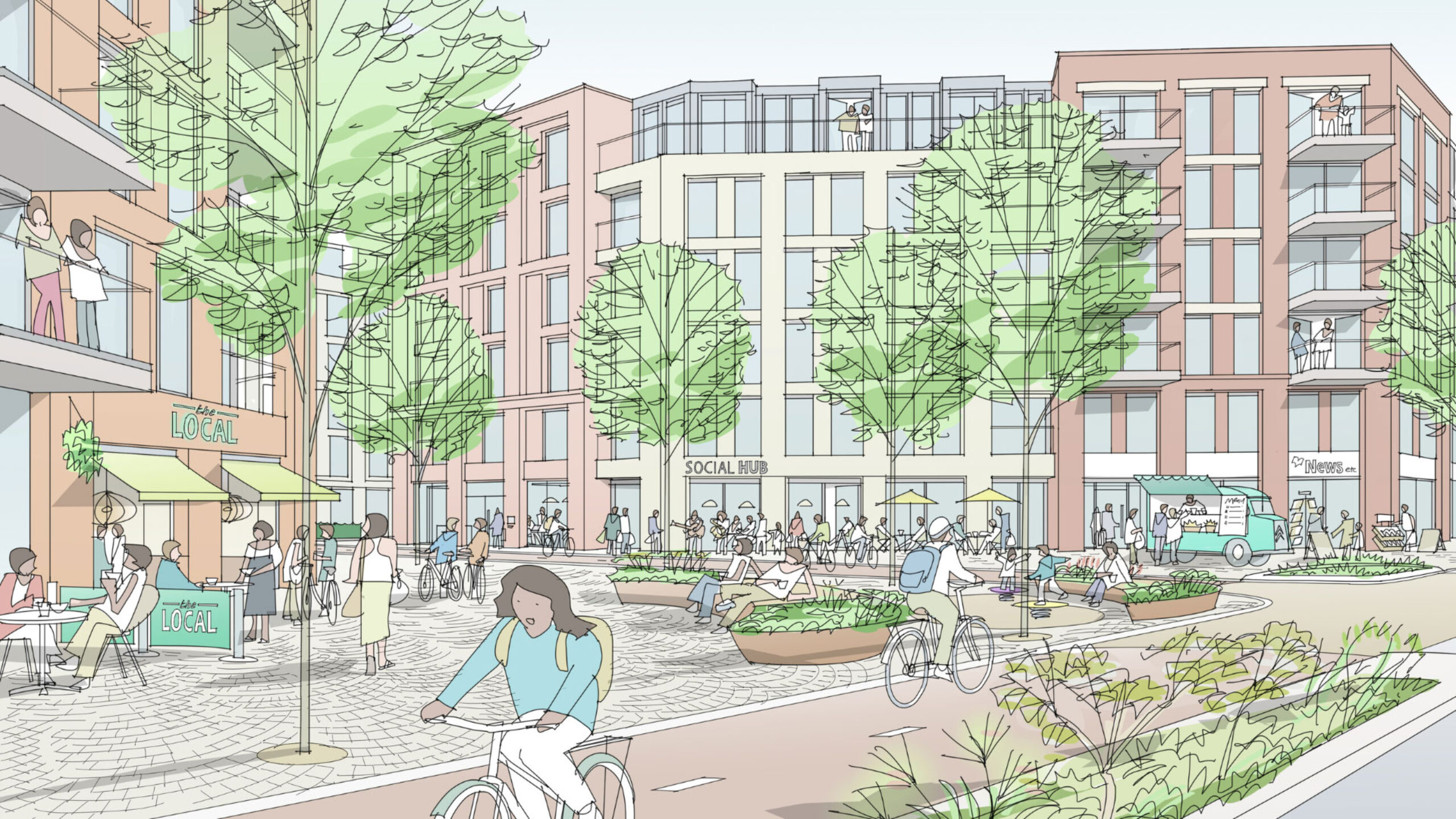
Design Thinking
Discussion | Shaping Future Places : Urban Regeneration
How do councils, designers, developers and the public work together to meet the challenge of regenerating our neighbourhoods?
Stride Treglown and Bristol City Council hosted their first Shaping Future Spaces event at Design West. Through the lens of the Whitehouse Street development in Bedminster, Bristol, the project team discussed the big issues in urban regeneration, and their impact on place, community and economy.
CONTEXT
Like many cities, the face of Bristol is changing. Shifting demographics are reflected in its altered skyline, with new commercial and residential developments rising up through the city centre and many neighbourhoods beyond, to meet demand. With a housing waiting list of 19,000 families in Bristol, the city has choices to make. To some, the expansion of our built environment speaks of opportunity and growth, while others remain uncertain about what it means for their community, and their city.
Stride Treglown brought experts from across the Whitehouse Street project team together to explore the reality of urban regeneration. Over the course of an hour, Richard Williams (Associate Urban Designer, Stride Treglown), Máire Grogan (Regeneration Manager, Bristol City Council), and Barney Cringle (Director of Place Research, Strategy & Impact, PRD) revealed the inner workings of this key strategic project, demonstrating how a considered approach to regeneration can allay concerns, address challenges, and unlock opportunities for the future.

PLACE
Urban regeneration is a process of transformation. When done well, it can revitalise declining urban areas, create buzzing and sustainable neighbourhoods, and boost the local economy in both the short and long term. The regeneration of Whitehouse Street aims to deliver these benefits. Identified as an area for significant redevelopment by the current Local Plan, it will see a primarily industrial site give way to a residential-led, mixed use neighbourhood that will deliver 2,000 new homes and a sustainable local economy.
‘Whitehouse Street is about creating a place that is connected to its surroundings and the people who live there, while also meeting the needs of the wider city,’ says Richard. ‘To achieve this, we’re looking beyond the traditional metrics of delivering X amount of houses and X amount of jobs. Instead, our framework takes a long-term view, coordinating investment and development in the area to ensure the needs of the local community, businesses and the wider city come together.’
Addressing infrastructure needs
Investing in social, economic and environmental infrastructure is vital to successful placemaking. As part of the wider Bedminster Green regeneration, the Whitehouse Street development incorporates major infrastructure projects including the district heat network and significant highways improvements. As well as benefitting the community, these important pieces of city infrastructure will ease the wider challenges Bristol has around transport and transition to net zero.
A well-connected neighbourhood relies on more than major infrastructure improvements, however. Another critical part of the Whitehouse Street Regeneration Framework is improving connectivity and mobility. This includes introducing active travel infrastructure, such as new cycle track and pedestrian routes, allowing people to travel to and from local amenities and transport connections without having to rely on their cars. ‘The Whitehouse Street Regeneration Framework is about ensuring investment opportunities are maximised for everybody,’ says Richard, Associate Urban Designer at Stride Treglown. ‘That means when funding becomes available it can be put in place in a coherent way that works with wider objectives to create a green neighbourhood, with high quality public space, that connects community and the city.’
Creating spaces that invite people to walk through, sit among, and socialise in is one of the most important pieces of social infrastructure for a community
Enhancing public spaces
Creating spaces that invite people to walk through, sit among, and socialise in is one of the most important pieces of social infrastructure for a community. These spaces also bring with them the dual benefits of supporting both environmental and long-term economic sustainability.
Because of this, the streets and public realm in and around Whitehouse Street will be redesigned, replacing concrete and hardstanding with pocket parks, soft landscaping, and more trees. This new green infrastructure will be joined up through the regeneration area to create a network of planting that connects to neighbouring green spaces, including improved play spaces in Victoria Park. Together, this will establish new ecological corridors and achieve at least a 10% biodiversity net gain for the area.
Beyond the landscape, improvements to local amenities and communities space are also well underway. Working with the East Street Property Partnership, which was launched by the mayor in November 2023, Bristol City Council are looking to reinvigorate the local high streets.
‘The purpose of the East Street Property Partnership was to bring local stakeholders together to try and secure leaseholders, and in time freeholders, for the vacant or underused premises along East Street and Bedminster Parade,’ says Máire. ‘These are the people who know the area, what it needs, and what residents want to see, and together we hope to establish a thriving high street that serves its community again.’
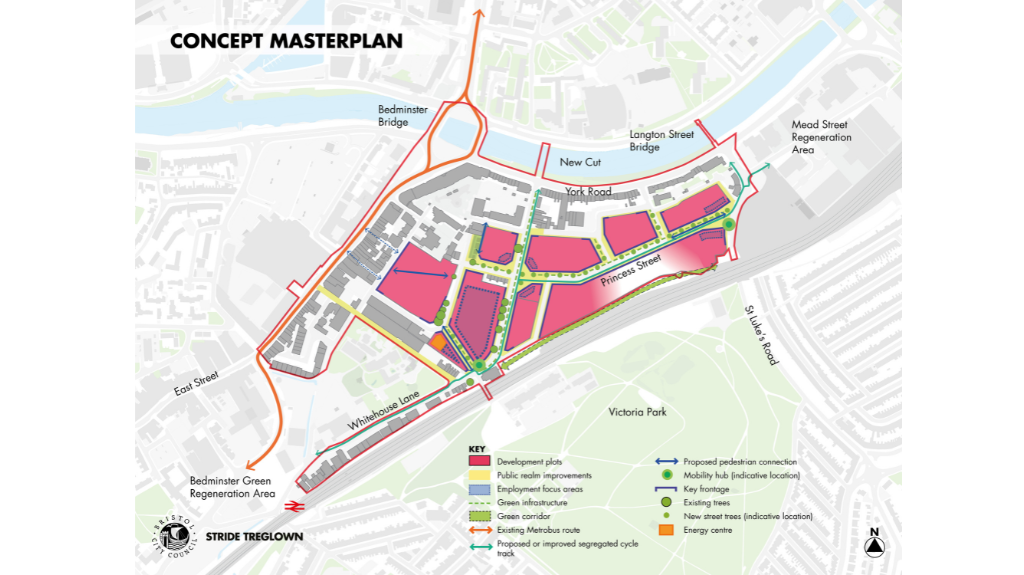
COMMUNITY
While improvements in infrastructure, public realm and connectivity will go a long way to establishing a sense of place and identity for Whitehouse Street within the city of Bristol, the project team was aware of the uncertainty such large-scale development can bring with it.
‘The Whitehouse Street development presents significant change in a small area of the community it is intended to serve, which understandably brings with it myriad concerns from local people.’ says Máire, Regeneration Manager at Bristol City Council. ‘This really underscores the importance of early and ongoing community engagement to shape the development and address some of those concerns.’
Appreciating that successful urban regeneration hinges on active community involvement, the Whitehouse Street team focused on engaging residents and businesses early and continuously to ensure the framework meets their needs and reflects their aspirations.
Inclusive planning
‘No community speaks with a single voice,’ says Richard. ‘We understand that we need to engage a whole cluster of people – from those who live in the area, to those who work in the area, to the businesses and landowners themselves.’
To do so, the development team worked closely with Action Greater Bedminster, an umbrella group for local stakeholders, to ensure the voices of all community members were heard. Further engagement took place through public workshops, community meetings, and a commitment to transparent communication to establish an ongoing dialogue and trust.
‘By being upfront, it meant focus could be given to areas of the community engagement where most impact could be achieved,’ says Richard. ‘From this, we enabled the community to create a manifesto which outlined their needs. What we also gained was a deep understanding into the history of the area and what people wanted to see moving forward, which helped shape the project far beyond technical considerations.’
While it is easy to focus on the local benefits of a project like Whitehouse Street, it is equally important to zoom out and think about urban regeneration schemes in the context of the greater city ecosystem
Building social capital
One of the most significant challenges in urban regeneration is building social capital and addressing concerns around displacement. While early and ongoing community engagement goes some way to helping, real action needs to be taken with the inclusion of affordable housing policies, and establishing the quality public spaces that are so vital to mitigating displacement and ensuring long-term community cohesion.
‘Although Bristol enjoys a reputation as a city with a vibrant and healthy economy, it is also home to some of the UK’s most deprived communities,’ says Barney, Director of Place Research, Strategy & Impact at PRD. ‘A lot of existing inequality challenges are becoming more embedded post-pandemic, with the gap between different communities widening as well. In this context, regeneration in Bristol provides an amazing opportunity to respond to these issues and build a more resilient and inclusive city.’
The city’s Local Plan identifies numerous areas of growth and regeneration through which both homes and supporting infrastructure can be delivered. Within this, Whitehouse Street represents a proactive response to the challenge, aiming to establish a mixed-use neighbourhood that supports social capital now and for the future.
‘We worked closely with the Cabinet to gain approval for Whitehouse Street’s inclusion in the Affordable Housing Practice Note Area,’ says Máire. ‘That means the affordable housing threshold is 20%, and we’re working closely with some of our partners to secure funding to support delivery. In response to public engagement, we’re also working with our schools colleagues and the NHS to plan for growth in GP and dental practices, as well as school places.’
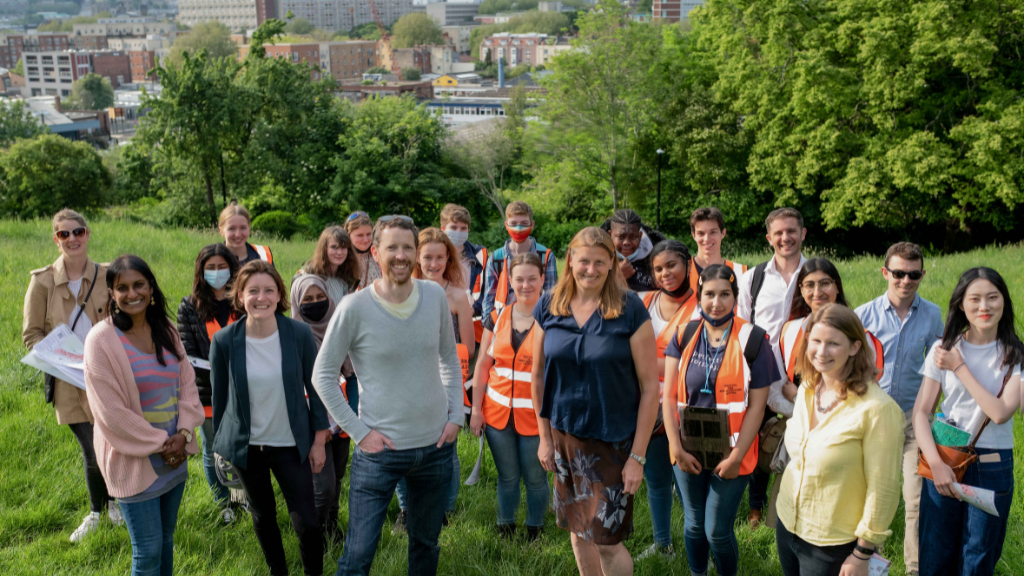
ECONOMY
While it is easy to focus on the local benefits of a project like Whitehouse Street, it is equally important to zoom out and think about urban regeneration schemes in the context of the greater city ecosystem.
‘At macro level, Bristol is known for having one of the UK’s strongest economies, and it is the only city outside of London to make a positive net contribution to the Exchequer,’ says Barney. ‘This reflects the strength of innovation and knowledge-intensive activities in the city economy. There has, however, been a decline in productivity in some of these key sectors in recent years, not least due to lack of affordable (and available) commercial space.
‘The strategy for Whitehouse Street presents the first opportunity in the city to develop and test a much more proactive and intentional approach to place-based regeneration. One that really does balance the needs of the future city economy against those wider fundamentals around housing delivery and infrastructure.’
Attracting investment
Whitehouse Street is currently identified as a principal industrial warehousing area, dominated by big industrial units. While the regeneration will retain some light industrial space to support the needs of the city’s urban services sector, it will also fulfil the longer-term need for a greater mix of industry and workspace typology.
‘Our approach includes both business retention and relocation,’ says Barney. ‘we’ve been working to understand local businesses to identify their needs and see how they can be accommodated within the development. Where this isn’t possible – because it won’t be possible in all instances – we need to understand what support they need to move elsewhere.’
Early planning around the types of spaces needed, and the new systems of working required to support the retention of local businesses and development of new sectors, ensures the needs of the economy can be firmly embedded within the ethos of the regeneration. Within this is a strategy to support employment, with the project team exploring opportunities to create pathways into work and training for local residents.
The real success of Whitehouse Street, and any regeneration, comes not in its completion, but in the longer-term outcomes
Long-term economic resilience
While the Whitehouse Street development is residential-led, there is more to its success than the creation of 2000 new homes. That is why the project team behind the regeneration framework has ensured that economic outcomes and wider social benefits are as deeply embedded as the delivery of quality housing.
‘Fundamentally, if a regeneration doesn’t work from a commercial perspective, we won’t see any of the economic, social and environmental benefits,’ says Barney. ‘So how we balance these types of value is incredibly important. We can only achieve that by thinking, at an early stage, about how we plan for the types of space we need, as well as new systems and ways of working that respond to that.’
The real success of Whitehouse Street, and any regeneration, comes not in its completion, but in the longer term outcomes. That is where the quality of the work, the resilience of the plan, and the happiness and wellbeing of future communities can really be seen.
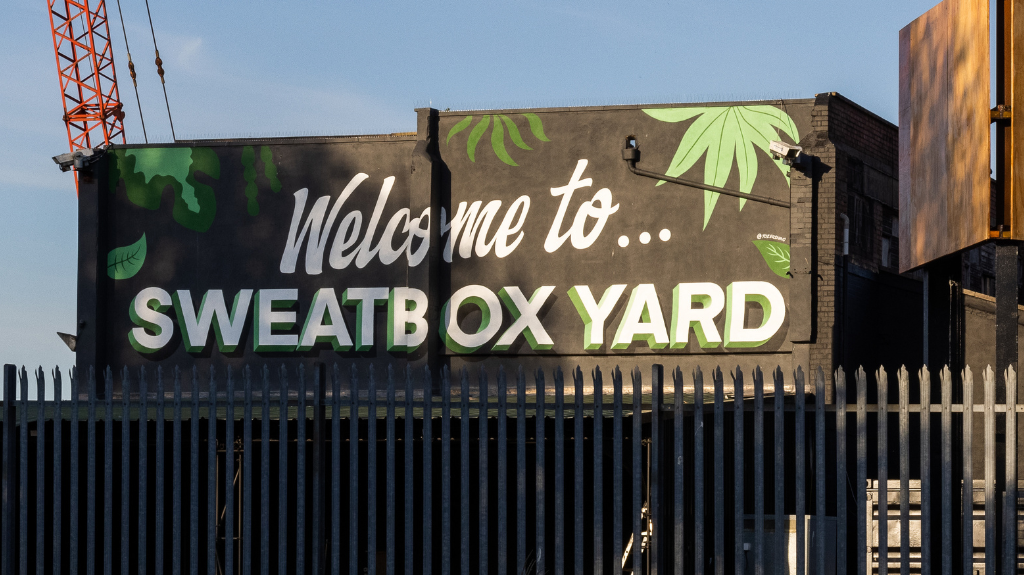
CONCLUSION
Successful urban regeneration hinges around establishing healthy, sustainable and resilient neighbourhoods that can serve current and future generations within the community, and across the wider city. Achieving this outcome, however, is a complex and ongoing process.
‘Our work at Whitehouse Street has been at local level, but we’ve always had an eye on how we can take the lessons learnt and scale them across the city,’ says Barney. ‘Within this, there’s a fundamental point in how we balance the different types of value, and how we make sure we’re maximising the value that comes out of regeneration in the city.’
‘That means looking beyond the immediate and short-term,’ says Richard. ‘We’ve always maintained a long-term vision for Whitehouse Street that sets the standard for development that works for everyone. That means establishing a well-connected neighbourhood that fulfils our responsibility to the local community, businesses, and the city of Bristol as a whole.’
Urban Regeneration: Place, Community and Economy was the first in a series of Shaping Future Places talks hosted by Stride Treglown at Design West. Sign-up to our newsletter link to stay up-to-date with the latest news and events from Design West.
If you’re interested in future events contact events@stridetreglown.com
You Might Also Like

